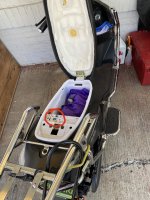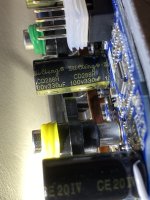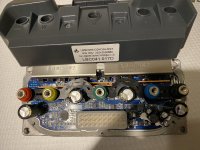Where do you find DC rated fuses for 60V and above?
Some results show up just looking for that phrase (most of the results are not relevant)
DC rated fuses for 60V and above - Google Search
Bussman and other companies make such fuses; Mouser, Digikey, Grainger, etc carry them, and they all have online chat assistants that can probably help you find the one you want. Sometimes you may find a large gap in voltage between the low-voltage stuff and the next available voltage group. For instance, the little fuses in my multimeters are typically rated only for low DC voltages, but there's one in my Fluke that's rated at something like 1000VDC (at a dozen amps or so, IIRC)...but it's a lot more expensive than the simple low voltage fuses.

(So I try to never hook up the meter wrong and pop it :lol:

).
Is arcing really a possibility with the 32V fuses I ordered?
Yes, it is a possibility with any fuse not *guaranteed* to operate at or above the voltage that will be used on the system. For a 60v system, that's a minimum of about 67 to 72v (full charge for 16s to 17s Li-Ion packs; other chemistries may have different max voltages). That's about twice what the rating on these fuses is.
It's pretty likely that for some percentage above the rating, they'll still probably work. 200% above? Maybe...I wouldn't suggest betting fire prevention on it.
But in this specific case, because the fuses in question have no specification sheet with limits, and curve charts for how they blow at what voltage and current and duration, there is no way to know if there is, or isn't, without actual real-world testing. Can't even tell how long it will take them to blow at what current level. You can guess that *if* (no way to know for sure) they are made of identical (not similar) metal alloys, with identical (not similar) physical design, size, thickness, etc. of the fuse metal as a brand-name that does have a spec sheet with this info, they will probably behave the same. But none of that info is available for them without testing, measuring, etc.
They might work fine. They might not. If you have several you can test to see at what voltage and current they fail to break the circuit, if you want to be sure.
Even brand name ones with a spec sheet are only *guaranteed* to break the circuit under the conditions listed on that....outside those conditions, it's a "maybe" or "no".
When the fuse blows, at 60V, what width gap is needed for an arc to occur?
I don't know the measurements; you can probably find how to calculate the "air gap" using the dielectric of air vs the voltage.
It may also depend on the current flowing at the time--the higher the current, the more ionized plasma will exist, and the easier it is for current to keep flowing.
One odd thing I notice with this moped is that with the key off and I connect the battery, I see and hear a loud spark. I assume it's from charging the electrolytic capacitors in the controller. What I don't understand is that if I remove the connection to the battery and reconnect it immediately, it will spark again. That means the caps got discharged immediately once the connection is removed but where did all that energy go? I can do that many times and it sparks every time.
The caps are probably small enough that they can only supply a tiny amount of energy to keep running the controller's LVPS that powers the MCU, motor halls, throttle, etc., and if there's a display they are also backfeeding it's LVPS for it's MCU, backlight, etc. It's not much current, but it's enough to draw out all the usable energy of the caps pretty quickly.
You can look over at a post I just made in another thread about precharge resistor size to see how the math works for time of charging; the inverse is true for discharging time vs load on them.
Hello everyone, new member first time posting to introduce myself, serial tinkerer and restorer of old things, coffee machines, houses, computers and scooters. Literally zero technical knowledge of anything but a keen student of specialist forums to gain the answers and ideas to undertake the...

endless-sphere.com
It also covers some of the breaker/fuse info.
Yes, the 2 batteries have their own charge ports and discharge ports (the dual interlocked circuit breaker). I have the single lead acid battery (cheaper) option which has no BMS. The Lithium option would have been $900 more for a 45 AH battery. Lead acid suits me fine. I get 35 to 40 miles riding it gently with no danger of fire (unless the fuse I am about to install start one)
If they are lead-acid, they dont' have any ports at all, because they have no BMS (the ports are specifically part of the BMS design).

So the breaker setup isn't actually needed, and would be easier on the batteries and probably give you a bit more range if you just directly paralleled both battery packs. (best is to parallel them at the individual battery level and the main + and - of the series set then just connects to your system, with one fuse and/or breaker between the main + and your controller/etc.
Such a one-pack-in-use-at-a-time breaker setup is only "required" for safety on a system with a BMS on each pack that has separate C & D ports, and that's only required because the way BMSes with FETs to control C & D work--they're not exaclty like switches, so they still allow current flow back thru them when off, in one direction (the other they prevent current flow). So two paralleled packs in this case (paralleled separately at their C ports and at their D ports) can leak back thru the other port when one of the ports is turned off to prevent overdischarge or overcharge, and so the BMS isn't actually able to protect against either one.
Lead-acid doesn't have any protection outside the charger (HVC) and controller (LVC) so it doesn't matter if they're directly paralleled all the time.
Same C & D port BMSed packs don't matter because the ports are setup in a way that prevents that leakage / backflow.







